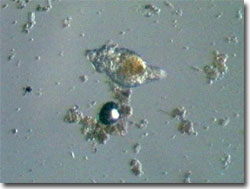Pond Life Digital Movie Gallery
Collotheca (Rotifera) Movies
Rotifers in the genus Collotheca are sessile and may form spherical colonies or attach singly to the substrate or to submerged aquatic plants, using a stout foot terminated by a short peduncle. Each rotifer secretes a gelatinous tube up to 650 micrometers in length that is used as a safe haven into which to retreat when disturbed.

Collotheca Video #1 - A rotifer ingests food items, reattaching its foot to the substrate before extending for each morsel; under oblique illumination with a playing time of 27 seconds. Choose a playback format that matches your connection speed:
Collotheca Video #2 - An individual feeds while traveling slowly across the field of view; under oblique illumination with a playing time of 32 seconds. Choose a playback format that matches your connection speed:
When safety is assured, the Collotheca extends itself from the tube and the infundibulum opens like a flower blossom. At the bottom of the infundibulum, cilia on the rim's edge sweep food into the mouth. These representatives of the phylum Rotifera are transparent, and digesting food can be observed in the intestine. For locomotion and feeding, members of the genus Collotheca use five tufts of relatively long tentacle-like cilia known as setae, surrounding the very large corona. Most rotifers possess chitinous jaws called trophi that are used for grinding ingested food. Often only the trophi are found as fossils, and the oldest, embedded in amber, date them to the Eocene epoch (38 to 55 million years ago).
Discovered first in the 1600s by Dutch microscopy pioneer Antoni von Leeuwenhoek, rotifers were dubbed "wheel animalcules" based on the resemblance of their feeding coronas to rotating wheels. As cell-constant animals, each individual of a Collotheca species has exactly the same number of cells, making them favorite living models for cancer research. Placed in the class Monogononta, there are 62 species of collothecan rotifers described worldwide. Five of the species are found in lake plankton and are not sessile as are their congenerics.
Contributing Authors
Cynthia D. Kelly, Thomas J. Fellers and Michael W. Davidson - National High Magnetic Field Laboratory, 1800 East Paul Dirac Dr., The Florida State University, Tallahassee, Florida, 32310.
BACK TO THE DIGITAL IMAGE GALLERIES
BACK TO THE OLYMPUS MIC-D DIGITAL MICROSCOPE
Questions or comments? Send us an email.
© 1995-2025 by Michael W. Davidson and The Florida State University. All Rights Reserved. No images, graphics, software, scripts, or applets may be reproduced or used in any manner without permission from the copyright holders. Use of this website means you agree to all of the Legal Terms and Conditions set forth by the owners.
This website is maintained by our
Graphics & Web Programming Team
in collaboration with Optical Microscopy at the
National High Magnetic Field Laboratory.
Last Modification Friday, Nov 13, 2015 at 01:19 PM
Access Count Since September 17, 2002: 22255
Visit the website of our partner in introductory microscopy education:
|
|
